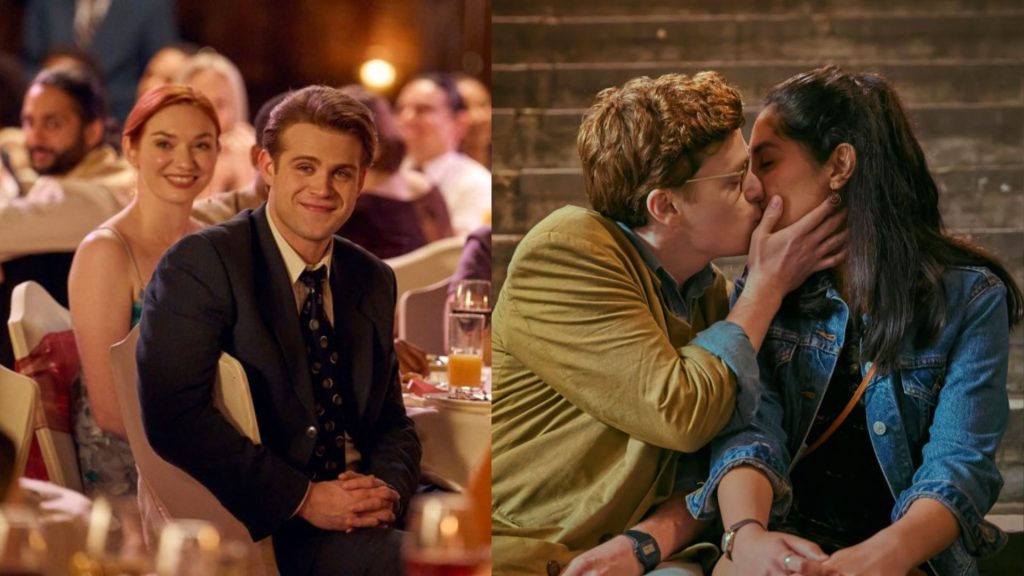After the recent success of One Day, similarities have been drawn to Normal People—another book-to-TV adaptation. In response, I’ve taken a look at why showcasing these honest coming-of-age stories that explore the difficulty of navigating early-adulthood connect viewers across the world.
Spoilers for Normal People (2020) and One Day (2024).
I first read One Day by David Nicholls and Normal People by Sally Rooney at very different, but equally transitional points in my life. The former, I read when I was starting secondary school, aged 13, and the latter, when I started university (coincidentally at the same place lead characters Marianne and Connell attended) aged 19. I associate One Day and Normal People with these formational points in time, and can vividly recall details from them both as if I read them yesterday. Therefore, it was with much relief that the 2020 Hulu adaptation of Normal People is a much-deserved global sensation, followed by Netflix’s One Day (2023). Fans of Em and Dex can finally enjoy an adaptation of One Day without cringing at Anne Hathaway’s much maligned Leeds accent in the 2011 film adaptation.
Netflix’s adaptation of One Day, starring Ambika Mod as Emma Morley (star of This is Going to Hurt) and Leo Woodall as Dexter Mayhew (star of The White Lotus), draws many comparisons to Hulu’s adaptation of Normal People: one comparison being their focus on loveable but confused central characters navigating young adulthood, as well as the narrative following relationships viewers can invest in. The film adaptation was perhaps a poisoned chalice, as the format of Nicholls’ book, which traces Emma and Dexter’s relationship on one day every year, is much more easily realised in series format. The novels One Day and Normal People have been previously compared, however with the release of the series adaptation of One Day, which takes a similar format to the adaptation of Normal People (with each episode lasting approximately 30 minutes and punctuated by a deliriously good soundtrack), more and more people are drawing comparisons between these two literary TV adaptations.

One Day and Normal People have captured audiences across the world because of their honest depictions of transitioning into life as a young adult. While not everyone in their early 20s has opportunities to holiday in chateaus or work in television, the fundamental crux of both stories is the confusion of having to pave your own path in life. In Normal People, Marianne and Connell (Daisy Edgar Jones and Paul Mescal) both fulfil very stereotypical roles in the microcosm of their Irish secondary school. However, when they move on to university, their roles as outsider and popular jock are upended, creating an unmoored feeling. Similarly in One Day, Emma considers herself to be an accomplished student who imagines changing the world, while Dexter has been buoyed up his whole life by his good looks and family’s money. However, when their star qualities fail to produce the futures they envisaged, everything falls apart. The appeal of their relationships is that they give viewers a sense of possibility of transcending their prescribed roles in society, and deeply connecting with those who exist outside of these conscriptive identities. While this is portrayed as liberating throughout Normal People and One Day, it also adds to the confusion that the characters feel while navigating their true identities in their early 20s. What keeps all of these characters tethered to the real world is their relationships with each other and how they bring one another back to their true sense of self.
There is a pervading sense of fated love in both Normal People and One Day, accompanied by a sense of wasted time. Marianne and Connell only get to know each other after years of being in the same school, and Emma and Dexter only introduce themselves on their last night of university in Edinburgh, and don’t romantically involve themselves until years later. Both stories acknowledge the power of fate which allows the characters to grow together and apart throughout each respective story. However, where Normal People excels as a character study, One Day excels as a study of a relationship, with ‘time’ as its own character in the relationship. This leaves the audience with a feeling of bated breath, while they wait for the happy ending. The viewer simultaneously wants to hurtle through each episode, while also trying to cling to the tenderness and vulnerability offered up in each. The appeal of Normal People and One Day lies in their shared capacity to draw the viewer into the worlds of these characters and to watch them unravel their knotted lives until the piece of thread runs directly to one another.
Present in all characters at different points in time is a lack of self-worth, which often manifests itself in their self-sabotaging relationships with other central and peripheral characters. Marianne grew up emotionally neglected, and so she becomes accustomed to relationships which mirror these patterns. She enters abusive relationships which enable her to switch off, as this is the behaviour she expects; whereas the emotional sincerity she is met with with Connell is out of her comfort zone. Similarly, Connell follows familiar patterns of rejecting his true sense of self, and consistently fears how others perceive him. This is a pitfall of many young people, and his emergence from this behaviour signals that he has matured dramatically beyond his secondary school self. It is obvious to the viewer that Marianne and Connell are delaying the inevitability of them being together, which can be frustrating but addictive viewing. This illustrates the messy reality of coming to terms with one’s sense of self and self-worth that most of us are confronted with in our early adulthood.

Many of us grow up watching sitcoms and movies which depict 20-somethings securing dream jobs while maintaining relatively happy relationships. While escapism has its merits, it is the mirror of reality which makes One Day and Normal People so gratifying for viewers. During Emma’s lowest period, in which she gives up on her writerly dreams and ends up in a dead-end job, she entangles herself in a relationship with Ian. As she grows and takes over the reins of her life, the need to shed him becomes visceral. The cringe-worthy moments make for toe-clenching, but amusing, viewing. Meanwhile, Dexter breezes through reams of beautiful rich girlfriends, who can slot into his reckless lifestyle well. Emma and Dexter seek out relationships in an attempt to confirm their believed status: Emma as a working-class person who is uncomfortable with vulnerability and often stands in the way of her own happiness, and Dexter who doesn’t truly know who he is and is fearful of people who challenge this. One Day and Normal People both succeed in depicting how we discover ourselves through those around us. The realistic struggle these relationships endure in order to ‘succeed’ renders both of these series highly watchable and endearing. The coming together of these relationships signals that these characters have finally found themselves.
Class is a major theme in both the books of Normal People and One Day, and the ability to further this exploration on screen gives the series adaptations an added layer of depth. Accent, dress, and the ability to ‘fit in’ in different social contexts illustrates how class is a major factor in determining how easy it is to adapt to young-adult life. While the characters drift together and apart, we witness how status can fracture relationships. The theme of class is rarely overtly discussed, however its presence in both relationships regularly makes itself felt. Dexter’s lack of accountability results in Emma walking away from the friendship for a number of years. Similarly, a rift grows between Marianne and Connell when she is met with acceptance and even popularity in social circles of Trinity College, while he struggles with imposter syndrome and loneliness. Despite these parallels, the class difference in the English context of One Day appears much less permeable in comparison to the class system at play in Ireland throughout Normal People.

When the stars align and both of these couples come together, the audience are afforded a brief sigh of relief. The success of these relationships, though seemingly unlikely at the start due to class and status differences apparent in both couples, has become the only conclusion the audience will be happy with. It is devastating therefore that neither series ends with the success we want. These characters stay with the audience long after the credits roll, and we can derive some satisfaction from the awareness that these characters brought each other happiness and alleviated each other’s loneliness during their turbulent coming-of-age years. The endless appeal of shows like Normal People and One Day is that they confide with the viewer that everything isn’t easy or fun during this period of life. Most importantly, they reassure us that it passes, and that those we love will be imprinted on us forever. Each character’s acknowledgement that they have undeniably altered one another’s lives becomes the conclusion that perhaps we don’t want, but need.
Words by Kate Burke
Support The Indiependent
We’re trying to raise £200 a month to help cover our operational costs. This includes our ‘Writer of the Month’ awards, where we recognise the amazing work produced by our contributor team. If you’ve enjoyed reading our site, we’d really appreciate it if you could donate to The Indiependent. Whether you can give £1 or £10, you’d be making a huge difference to our small team.
